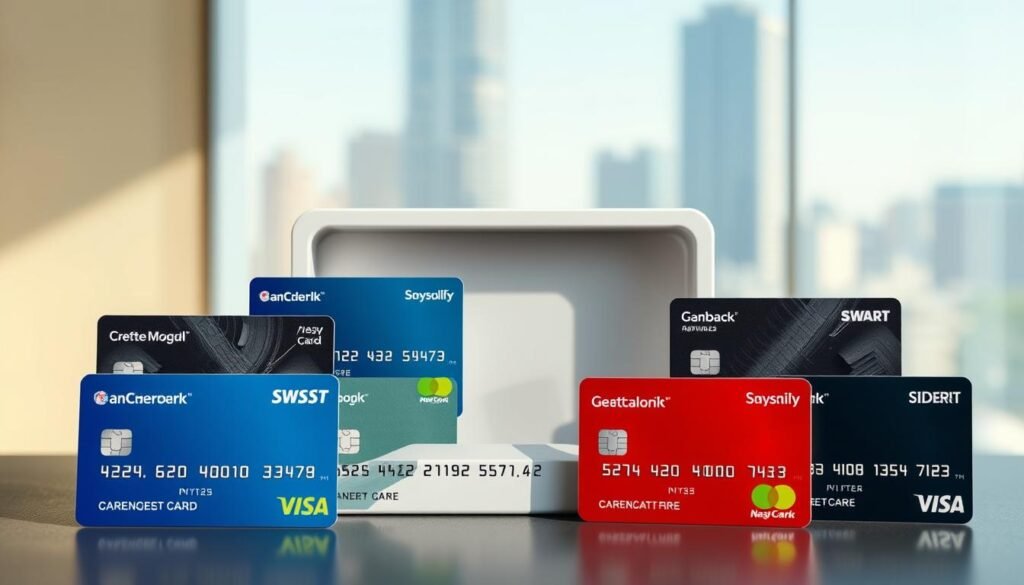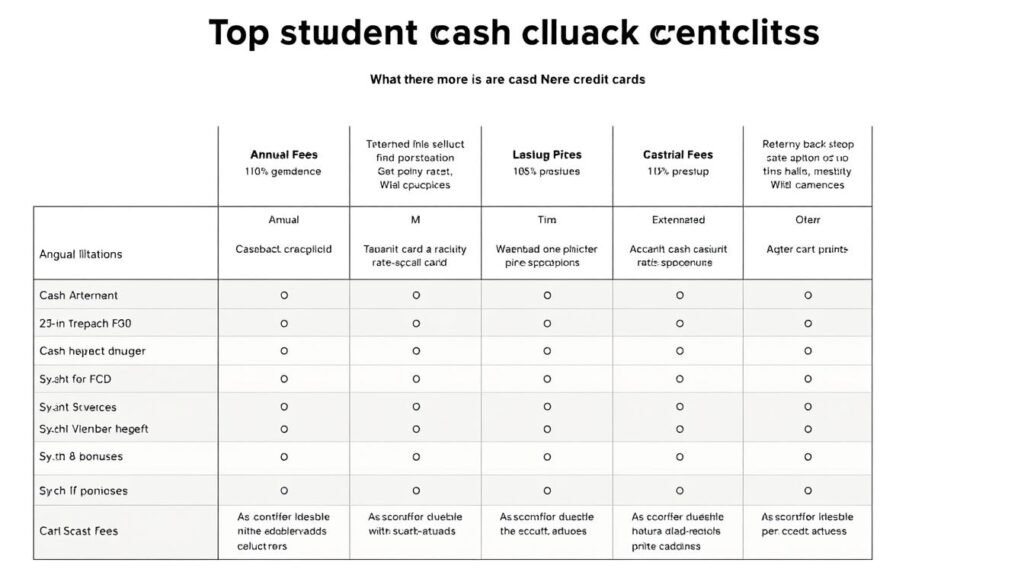
Find the Best cashback credit cards USA students best options

You might feel overwhelmed picking a starter card while juggling classes and rent. I get it I’ve helped many people pick the right product for their life and goals. In this roundup I’ll show you clear choices, side-by-side tables, and step-by-step next steps so you can compare, apply, and start earning cash back without stress.
You’ll find zero annual fee picks from Capital One, Discover, Chase, and Bank of America. I’ll flag offers like $50 early spend bonuses, 25,000-point promos, and rotating 5% categories.
This guide covers which cards accept thin files or no history, alternatives for international applicants, and simple tactics to protect your credit score.
- Why you’re here: compare today’s top student cash back cards at a glance
- Editor’s picks for students in the U.S. right now
- cashback credit cards USA students best options
- Side‑by‑side comparison table: rewards, intro offers, APR, fees
- How to choose the right student credit card for your budget
- Card deep dives: strengths, tradeoffs, and who should get them
- If you’re new to credit or rebuilding: secured and alternative paths
- Maximize your rewards without overspending
- Avoid common pitfalls that cost students money
- Study abroad and acceptance: what to use outside the U.S.
- Application checklist: get student credit without surprises
- Credit building game plan from day one
- Welcome offers and first‑year boosts you can actually earn
- Travel rewards for students who prioritize trips over cash back
- Photos to enhance your comparison journey
- Photo 1: Student tapping card at campus cafe cashback credit cards USA students best options
- Photo 2: Laptop with budget spreadsheet cashback credit cards USA students best options
- Photo 3: Airport scene with student traveler cashback credit cards USA students best options
- Photo 4: Gas station fill-up using card cashback credit cards USA students best options
- Internal resources from StudyFinance to deepen your decision
- Authoritative references you can trust
- Your next step: pick a card, apply with confidence, and start earning
Why you’re here: compare today’s top student cash back cards at a glance
A one-glance comparison lays out fees, rewards, and approval friendliness so you can shortlist in minutes.
This quick snapshot highlights cards with $0 annual fee, which report to all three bureaus and which reward models fit typical campus spending. You’ll see flat-rate earners, rotating category winners, and portal-boost programs so you can match a rewards credit card to your routine.

| Model | Typical earn | Perks | Who it fits |
|---|---|---|---|
| Flat-rate | 1.5% everywhere | $0 annual fee, easy tracking | Low maintenance spenders |
| Rotating | 5% categories (quarterly) | Higher seasonal returns; activation needed | Students with varied category spend |
| Portal boosts | Bonus via shopping portals | Extra multipliers for online buys | Frequent online shoppers |
| Intro APR | 0% on purchases | Short-term financing for planned buys | One-time big purchases |
Tip: Follow quick links to deep dives and verify issuer terms (external links should be nofollow). Matching your spending helps protect your credit score and get more from cash back purchases.
Editor’s picks for students in the U.S. right now
Use this quick set of editor favorites to match a card to how you live on campus. Each pick lists a short rationale and an immediate takeaway so you can scan and act.

Capital One Savor Student Cash Rewards
Why: Big bonuses on dining and entertainment (8% via Capital One Entertainment, 5% travel) and a $50 early spend bonus after $100 in three months.
Takeaway: Ideal if you go out often and stream a lot, with $0 annual fee.
Discover it Student Cash Back
Why: Rotating 5% categories (activation required) plus Cashback Match at year end.
Takeaway: Best for seasonal category hunters who will activate each quarter.
Discover it Student Chrome
Why: Simple 2% at restaurants and gas with no activation and Cashback Match.
Takeaway: Set-and-forget earning for everyday campus spend.
Chase Freedom Rise
Why: Starter line that accepts applicants with little or no history and pays 1.5% back.
Takeaway: Use it to build on-time history; account reviews can lead to upgrades.
Bank of America Travel Rewards for Students
Why: 1.5x–3x points, 25,000-point welcome after $1,000 in 90 days, and a long 0% intro APR on purchases.
Takeaway: A travel-focused route if you already have some credit established.
Capital One Quicksilver Student Cash Rewards
Why: Flat 1.5% everywhere, plus 5% via Capital One Travel and a $50 early spend bonus.
Takeaway: Reliable flat-rate cash rewards credit for easy tracking.
Firstcard Secured Credit Builder
Why: No credit check and no SSN required for many international applicants; subscription fee applies.
Takeaway: Practical entry path for those who can’t or won’t do a hard check.
Discover it Secured Credit Card
Why: Earn rewards on a secured line and get considered for an upgrade later with no annual fee.
Takeaway: Build history while still earning rewards and aiming to graduate to an unsecured line.
Self Secured Visa
Why: No hard credit check and low intro fees, but it can’t be used internationally.
Takeaway: Good for domestic building; plan a backup for travel.
Quick next step: Compare these picks in the Credit Cards category roundup and check issuer terms on their pages (use nofollow links when you apply).
cashback credit cards USA students best options
Begin with the simple rule: the right card mirrors your regular purchases.
You define "best" by fit. Match rewards to your weekly cash back purchases, watch the annual fee, and confirm the network you need for travel or online shopping.
Key checks:
- Map your spend: flat-rate rewards credit card if your buys are varied; category-driven if you eat out or fill up often.
- Fee sensitivity: most top picks carry $0 annual fee, so prioritize those if you want steady value.
- Network and acceptance: Visa and Mastercard work widely; Discover and AmEx can be limited abroad.
- Reporting: choose cards that report to all three bureaus so on-time payments help your credit score.
Short campus shortlist by lifestyle
- Dining & entertainment: a category card that pays higher rates on restaurants.
- Commuters (gas): a travel or gas-focused rewards credit card with strong gas rates.
- Frequent travelers: no foreign transaction fee and Visa/Mastercard acceptance.
- Subscription-heavy users: a flat-rate cash rewards credit makes recurring payments simple.

Also consider intro offers and portal-only boosts, but don’t overspend chasing bonuses. If you want more on managing student finances and accounts for international learners, see savings and account guides for related tips.
Side‑by‑side comparison table: rewards, intro offers, APR, fees
Compare headline earn rates, welcome bonuses, and foreign fees in the concise chart that follows. Use it to narrow your pick to two finalists based on real monthly spend.
| Card | Earning highlights | Intro & APR | Annual fee / Foreign fees |
|---|---|---|---|
| Capital One Savor Student | 8% entertainment; 5% travel | $50 after $100 in 3 months; standard APR range applies | $0 / $0 |
| Discover it Student Cash Back | 5% rotating (activation); Cashback Match | No welcome cash bonus; standard APR | $0 / typically $0 |
| Discover it Student Chrome | 2% restaurants & gas; Cashback Match | No welcome cash bonus; standard APR | $0 / typically $0 |
| Capital One Quicksilver Student | 1.5% flat; 5% via portal boosts | $50 after $100 in 3 months; standard APR | $0 / $0 |
| Chase Freedom Rise | 1.5% flat | No welcome cash bonus; standard APR | $0 / check issuer terms |
| BoA Travel Rewards Student | 1.5x–3x points | 25,000 pts after $1,000 in 90 days; 0% intro APR (15 cycles) | $0 / $0 |
| Firstcard Secured | 1%–15% (subscription tiers) | No hard check; subscription fee instead of typical APR model | $72–$144 / check terms |
| Self Secured Visa | No rewards | $0 first year; $25 after | $25 after year 1 / not valid internationally |
| Discover it Secured | 1%–2%; Cashback Match | No welcome cash bonus; standard secured APR | $0 / typically $0 |
Quick notes: Rotating categories need activation and may cap earnings. Intro APR offers and welcome bonuses are time‑sensitive; confirm exact dates. Always verify issuer terms before applying — link to category pages on StudyFinance as a dofollow resource and use issuer T&Cs as nofollow confirmation when you apply.
How to choose the right student credit card for your budget
Begin with a simple tally of monthly spend to match rewards to the places you shop most. Track dining, groceries, gas, subscriptions, travel, and other cash back purchases for one month.
Match your monthly spend to categories that earn cash back
Step 1: Total each category and pick a rewards credit card that boosts your top two categories. If you mainly eat out, a restaurant-focused option pays more than a flat-rate one.
Watch for foreign transaction fees and international acceptance
Step 2: If you study abroad or shop from foreign sellers, check foreign transaction fees and network acceptance. Choose Visa/Mastercard if you need wide acceptance.
Prioritize $0 annual fee and reporting to all three bureaus
Step 3: Start with a $0 annual fee student credit card that reports to all three bureaus so timely payments help your credit score.
- Decide whether rotating categories will fit your routine or if set-it-and-forget-it earning is better.
- Compare portal bonuses versus direct booking convenience.
- Use intro APR only if you can pay the balance within the offer window.
"Match rewards to real spend, not to wishful thinking."
For a short primer on handling offers and timing applications see credit basics and application timing.
Card deep dives: strengths, tradeoffs, and who should get them
Below are concise deep dives that highlight strengths, tradeoffs, and who benefits most from each card.
Capital One Savor Student
Why it stands out: 8% on entertainment and 5% on travel via issuer portals, plus a $50 early-spend bonus. $0 annual fee and no foreign transaction fee.
Who it's for: You who go out often or buy event tickets. Tip: route purchases through Capital One Travel to capture the 5% and set alerts for the early-bonus window.
Discover it Student Cash Back
Why it stands out: Rotating 5% categories (activation required) and a Cashback Match at the end first year. 0% intro APR on purchases for six months; $0 annual fee.
Who it's for: Organized spenders who will activate each quarter. Tip: add calendar reminders to maximize the bonus categories.
Discover it Student Chrome
Why it stands out: Simple 2% at restaurants and gas with no activation and year‑end Match. $0 annual fee makes it low maintenance.
Who it's for: Commuters who fuel up regularly and want steady returns without tracking rotating categories.
Chase Freedom Rise
Why it stands out: 1.5% back everywhere, forgiving approval for thin files, and account reviews that can lead to upgrades. $0 annual fee.
Who it's for: You building history. Tip: use it as a primary spend for steady 1.5 cash back and set up autopay to build a clean record.
BoA Travel Rewards Student
Why it stands out: 1.5x–3x points, 25,000-point welcome after $1,000 in 90 days, and a long 0% intro APR on purchases. $0 annual fee and no foreign fee.
Who it's for: Future travelers who can time their major buys in the first 90 days. Tip: plan needed purchases into the intro window to earn the bonus without interest.
Quicksilver Student
Why it stands out: Flat 1.5% everywhere and boosted 5% via Capital One Travel, plus a $50 early spend bonus and no annual fee.
Who it's for: You who prefer set‑and‑forget earning. Tip: pair this with a rotating card if you can manage two accounts for maximum value.
Quick checklist: confirm $0 annual fee, enable online access, and set autopay. For current APRs and exact terms, review issuer pages (use nofollow links when applying) and compare broader analyses like this side‑by‑side review.
If you’re new to credit or rebuilding: secured and alternative paths
If you're building or rebuilding your score, secured and alternative routes let you start safely and predictably.
Who should consider these paths? You will if you have little history, a recent setback, or no Social Security number and need reliable approval odds.
Discover it Secured: earn cash back now, potential upgrade later
Why pick it: You earn rewards and get Cashback Match during the first year. There’s no annual fee and issuers review accounts for upgrades over time.
Tip: Set autopay and aim for a 90‑day streak of on‑time payments to speed progress toward an unsecured upgrade.
Self Secured Visa: build via Credit Builder Account, no hard credit check
Why pick it: No hard check on application and a Credit Builder Account helps you show on‑time payments. The first year often has no annual fee, then a small fee applies.
Note: This product may not work outside the U.S., so plan an alternative for travel.
Firstcard Secured: no credit check, options for international applicants
Why pick it: You can apply without a Social Security number by using passport or visa info. It reports to bureaus and offers cash back while you build credit history.
Watch: Subscription costs vary, so weigh fees against the value of early account access.
- Use one secured account, keep utilization low, and pay in full each month.
- Monitor scores monthly and request limit increases when eligible.
- After 3–6 months of solid payments, ask your issuer about upgrade paths to an unsecured credit card.
"Start small, prove on‑time payments, then move up when your issuer invites you."
For a step‑by‑step secured‑to‑unsecured roadmap, check our internal building credit guide for details and timing.
Maximize your rewards without overspending
A few simple steps can raise what you earn without raising what you spend. Start with clear rules so you don’t chase bonuses that lead to impulse buys.
Activate rotating categories and set calendar reminders. For cards with quarterly bonuses like Discover’s 5% categories add calendar alerts. Activate each quarter and log caps so you switch to a backup card after limits hit.
Stack student discounts, dining apps, and portal bookings
Combine student deals, restaurant apps, and portal rates (for example, Capital One Travel) when the net price matches direct booking. This stacking helps you earn cash back while keeping costs steady.
Consider adding a trusted family member as an authorized user on your credit card account to consolidate household spend. Keep utilization low and keep clear rules so shared use does not raise your risk.
Redeem smartly: statement credit vs travel
Pick redemptions that match your goals. Use statement credit for simplicity and travel redemptions when point values outpace flat returns. Always check caps, fees, and issuer terms.
- Set budgeting app tags to confirm you’re hitting the right card for each purchase.
- Time necessary buys into the first 90 days to meet welcome targets — don’t buy extras just to earn a bonus.
- Review monthly statements and contact the issuer promptly if a bonus is missing.
For deeper tactics and stacking strategies, see StudyFinance’s rewards strategy guide for step‑by‑step help.
Avoid common pitfalls that cost students money
Small mistakes with timing and payments can erase months of rewards and harm your score.
Keep this short checklist in mind. High APR balances, missed deadlines, and extra fees quietly eat value. Use clear steps to protect your cash back and your credit score.
Carrying a balance erodes rewards with high APRs
Student APRs vary and can be steep. A balance at a high rate often costs more than what you earn in cash back.
Prevention: set autopay for the full statement amount and aim to keep utilization under 30% (ideally under 10%).
Missing the "first three months" intro spend window
Many offers require a qualifying purchase in the first three months to get a $50 or larger bonus.
Plan needed purchases into that window rather than buying extras. Track deadlines in your calendar.
Overlooking foreign transaction fees during study abroad
Foreign transaction fees vary by issuer. Some student credit cards charge $0, others add 1%–3% per purchase.
Check terms before travel and carry one no‑fee card for abroad use.
| Pitfall | Typical cost | Easy fix |
|---|---|---|
| High APR balance | Months of lost rewards | Autopay full balance |
| Missed intro window | Lose welcome bonus | Plan purchases in first three months |
| Foreign fees | 1%–3% per foreign purchase | Use a $0 foreign fee card |
| Late payments | Penalty APR, lower score | Set reminders and alerts |
"Avoid short‑term gains that cost long‑term trust with issuers."
Study abroad and acceptance: what to use outside the U.S.
When you study abroad, the network your card uses can make or break a purchase. Before you leave, check which networks local shops accept and confirm fees so you don’t face surprise surcharges.
Network acceptance:
Visa and Mastercard acceptance vs Discover and American Express
Visa and Mastercard work in far more places worldwide. You’ll want at least one Visa or Mastercard for daily purchases, transit, and small vendors.
Discover and American Express can be limited in some markets. Keep a backup from a major network if a merchant won’t accept your primary card.
No foreign transaction fee issuers to consider for travel
Pick cards with $0 foreign transaction fees to avoid the usual 1%–3% extra cost per purchase. Bank of America Travel Rewards for Students and many Capital One student products charge no foreign transaction fees and work well for travel rewards credit strategies.
- Prioritize a Visa or Mastercard network for wider acceptance.
- Carry a backup network and a small cash reserve for places that don’t take cards.
- Notify issuers of travel dates to avoid fraud holds and enable chip-and-PIN when available.
- Download your issuer app for instant alerts and quick card lock if a problem arises.
- Save receipts and note international contact numbers; check issuer fee tables (nofollow) before you fly.
"Carry a primary global network card, a backup, and a little cash and you’ll avoid most foreign hassles."
| Issue | Quick fix | Why it matters |
|---|---|---|
| Limited acceptance | Carry Visa/Mastercard backup | Less risk of declined purchases |
| Foreign transaction fees | Use no‑FTF issuer | Saves 1%–3% per foreign purchase |
| Fraud holds | Notify issuer before travel | Keeps your card active abroad |
Application checklist: get student credit without surprises
Prepare documents ahead to avoid last‑minute stress when you apply for a student credit card. Having everything ready speeds approval and helps you avoid unnecessary hard pulls.
What issuers typically ask for
You’ll need your legal name, date of birth, address, school, and income sources. Provide a Social Security number where asked; some products accept passport or visa details instead.
Hard vs soft checks and timing
Soft prequalification shows likely approval without affecting your credit score. A hard inquiry may lower your score briefly, so avoid multiple applications in a short window.
Under 21? Practical routes
If you are under 21, document independent income or use an authorized user route. Many issuers don’t allow co‑signers, so proof of work or financial support helps.
Step‑by‑step checklist
- Gather ID, school info, and income proof.
- Confirm SSN or passport/visa acceptance for international applicants.
- Check reporting to all three bureaus and annual fee, intro APR, and FTFs.
- Prequalify softly, then apply when you meet offer timelines.
- Set up online access and autopay once approved.
| Item | Why it matters | Action |
|---|---|---|
| ID & school | Verifies student status | Upload or enter exact names |
| Income proof | Shows ability to pay | Pay stubs or bank statements |
| SSN / passport | Used for identity checks | Provide SSN or accepted passport/visa |
| Prequalification | Protects your credit score | Use soft checks first |
"Apply when you meet requirements, not when you want a fast bonus."
For step‑by‑step application guidance and to learn how to get student credit with confidence, see the StudyFinance application guide for a dofollow walkthrough.
Credit building game plan from day one
Lay out a simple month-by-month plan so you build positive history from day one. Small, steady moves beat risky shortcuts. Follow this routine to protect your score and get practical value from your student credit experience.
Set autopay, keep utilization under 30%, and monitor scores
Turn on autopay for the full statement balance to avoid interest and late fees. Most issuers offer free score tools you can check monthly.
Keep utilization under 30% and aim for under 10% when possible. Low utilization helps your credit score grow faster.
Track your score monthly and dispute errors quickly. Use issuer dashboards or StudyFinance for guidance: StudyFinance Credit Basics and Monitoring.
Use the card monthly, pay in full, and keep oldest accounts open
Charge one small recurring purchase each month and pay it in full. This keeps your account active without adding risk.
Avoid closing the oldest account; age of accounts matters for build credit history.
- Request a limit increase after 6–12 months of on-time payments.
- Space new applications by several months to avoid back-to-back hard pulls.
- Keep a simple budget so you don’t overspend chasing rewards.
- Review statements for errors and category opportunities every month.
| Action | When | Why it matters |
|---|---|---|
| Autopay full balance | Immediately | Prevents interest and late fees |
| Use card monthly | Each month | Keeps account active and reports on-time payments |
| Monitor score | Monthly | Spot errors and measure progress |
| Request limit increase | 6–12 months | Improves utilization ratio |
"Start small: steady, timely payments build trust with issuers and lead to better offers."
Welcome offers and first‑year boosts you can actually earn
Welcome bonuses can add real value if you schedule qualifying purchases smartly.
How the Discover Cashback Match works: Discover doubles the cash back you’ve earned at the end first year by matching the totals you’ve earned end first year. That means every small reward you get during months 1–12 is effectively doubled at year end. Plan steady, routine spend so the cash back ’ve earned compounds into a meaningful sum.
Easy timing and example offers
Capital One student credit card promos often give $50 after $100 in the first three months. Bank of America’s travel student offer pays 25,000 points after you make at least 1,000 in purchases first 90 days.
- Front‑load predictable bills (subscriptions, utilities) into the first three months to hit $50 early spend bonuses without extra buys.
- Track weekly checkpoints so you reach 1,000 purchases first window for BoA bonuses.
- Pay every balance in full to avoid interest while chasing points make least targets.
| Offer | Requirement | Quick tip |
|---|---|---|
| Discover Match | Any cash back earned year 1 | Use set purchases monthly to grow matched amount |
| Capital One $50 | $100 spend in first three months | Move recurring fees into card billing cycle |
| BoA 25,000 pts | At least 1,000 purchases first 90 days | Split big planned buys across weeks if needed |
Final step: review issuer terms on their pages, monitor progress monthly, and celebrate a realistic, budget‑aligned win instead of forcing spend.
"Plan small, predictable purchases and let matched rewards do the heavy lifting."
Travel rewards for students who prioritize trips over cash back
When you plan real travel, points that convert to flights or hotels often outpace a simple flat return. This section helps you decide when a travel rewards credit approach trumps a steady cash return.
When points per dollar beat 1.5% cash back
Compare the actual value you get at redemption. If an airline seat or hotel night costs fewer points than the cash equivalent, your points per dollar can exceed 1.5x value.
Factor in welcome bonuses, like a 25,000‑point offer after $1,000 in 90 days, which can tilt the math in favor of travel rewards.
Bank of America Travel Rewards for Students earns 1.5x–3x points, carries a long 0% intro APR on purchases, and has no annual fee or foreign transaction fee useful for international trips.
You can redeem points as statement credits against travel and dining purchases, which simplifies tracking and preserves flexibility.
- Line up necessary travel or subscription spend with the welcome window to hit bonus thresholds without extra buys.
- Keep a flat‑rate backup card for non‑bonus categories so everyday spend still earns steady value.
- Check portal pricing vs direct bookings to avoid paying more and devaluing your points.
- Review issuer redemption terms so eligible charges post correctly.
- Plan redemptions before any expiration window and keep records of travel purchases.
"Use travel points when your redemption value exceeds a simple cash rate and pair with a flat backup for steady returns."
For a deeper strategy, see the StudyFinance travel rewards primer for step‑by‑step tactics and examples.
Photos to enhance your comparison journey
Visuals make it easier to link numbers to actions. Good photos help you see where a rewards credit card pays off in daily life. They also guide quick choices without extra research.
Photo 1: Student tapping card at campus cafe cashback credit cards USA students best options
Use: Match dining spend to a high-rate dining category. A simple cafe photo shows where small, frequent cash back purchases add up.
Photo 2: Laptop with budget spreadsheet cashback credit cards USA students best options
Use: See how budgeting keeps annual fee impact low and tracks progress toward welcome offers.
Photo 3: Airport scene with student traveler cashback credit cards USA students best options
Use: Visual cues remind you to pick a no‑foreign‑fee card for travel and to route bookings through portals when it helps.
Photo 4: Gas station fill-up using card cashback credit cards USA students best options
Use: Fuel photos highlight where a gas category or flat-rate card shines for commuters.
| Scene | Why it matters | Quick tip |
|---|---|---|
| Campus cafe | High-frequency dining spend | Use dining category card |
| Budget laptop | Track cash back purchases | Export statements monthly |
| Airport | International acceptance & fees | Carry a no-FTF backup |
| Gas station | Commuter fuel savings | Use gas-focused or flat-rate card |
"Match visuals to your routine the right image reveals where rewards add real value."
Internal resources from StudyFinance to deepen your decision
If you want a clearer path, use our hub pages to move from research to action. Start with targeted guides that show how to compare a credit card side‑by‑side, and then use tools that map rewards to your real monthly spend.
Where to go next on StudyFinance:
- Credit Cards deep dives, updated comparisons, and optimization tips to help build credit and choose a student credit card that fits your routine.
- Student Finance basics budgeting templates, debt management guides, and steps to start building credit responsibly.
You’ll also find calculators to estimate how much you will earn cash back based on actual spend. Use these to evaluate annual fee tradeoffs as your profile grows.
Practical tools and templates
- Rewards calculator to model monthly earning and break‑even points.
- Intro offer tracker and category calendar templates to time purchases.
- Step‑by‑step application and reconsideration checklists to reduce surprises.
Keep one rule in mind: use the guides to align a card with your budget so you earn value without extra spending and to help build credit steadily.
"Use tools, not guesswork a small plan beats chasing offers."
Before you apply, verify headline offers and scoring guidance with primary sources. Relying on issuer disclosures and FICO materials keeps your decisions factual and defensible.
Why check primary sources: issuer pages publish current APRs, reward structures, foreign transaction fees, and any annual fee or promo timing. FICO explains how payment history, utilization, account age, new accounts, and credit mix shape your credit score.
Issuer terms and rates pages for card details
Before you apply, read the issuer’s terms to confirm exact APRs, billing cycle dates, and whether a credit card issuer reports to all three bureaus. Keep screenshots or PDFs of key pages for future reference.
FICO education on credit scoring and utilization
Use FICO resources to set a personal utilization target and payment schedule. Their guides help you understand how on‑time payments and low usage improve your credit score over time.
- You’ll verify current APRs, rewards, and annual fee details on issuer pages before you apply.
- You’ll check foreign transaction fee tables and network acceptance notes from each credit card issuer.
- You’ll review offer timelines in writing, including any $50 or points-based promos.
- You’ll read FICO guidance (nofollow) on how payment history and utilization shape your credit score.
- You’ll compare issuer disclosures for billing cycles that affect intro APR and bonus windows.
| What to verify | Where to find it | Why it matters |
|---|---|---|
| APR & intro rate | Issuer rates page (nofollow) | Shows cost of carrying a balance and intro window length |
| Annual fee & foreign fees | Fee schedule on issuer site (nofollow) | Impacts net value of any offer |
| Reporting to bureaus | Issuer disclosures | Affects whether on‑time payments help your credit score |
| Promo timelines & caps | Offer terms (nofollow) | Determines if you can meet spend thresholds without overspending |
Final tip: pair these authoritative sources with our comparisons to make confident choices. Revisit issuer pages and FICO guidance annually because rates, benefits, and scoring advice can change.
Your next step: pick a card, apply with confidence, and start earning
Narrow your list to a couple of realistic picks and plan the steps to apply.
Quick checklist: pick two finalists that match your biggest monthly categories and travel needs. Confirm many top student picks offer a $0 annual fee and report to all three bureaus so your on‑time payments help you start building credit.
Then verify current terms on issuer pages (use nofollow links for issuer T&Cs), apply for one credit card you’re likely to get to avoid multiple hard pulls, and set up autopay and alerts on day one.
Map your first 90 days of spend to meet realistic welcome targets, track rotating categories or stick to a flat-rate plan you can maintain, and revisit your setup in six months. For ongoing tips and updated student-friendly picks see our Credit Cards hub.
If you want to know other articles similar to Find the Best cashback credit cards USA students best options you can visit the category Finance.






Leave a Reply